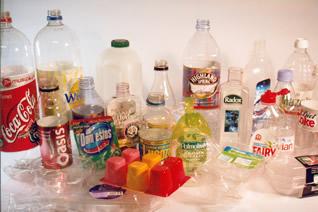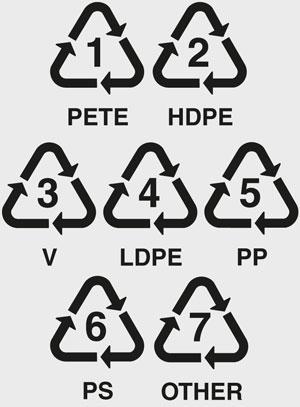|
|
Facts About Plastics: Which Types To Avoid
Posted by Pile
(41746 views) |
 [Industry] |
 There's a lot of controversy surrounding recent stories about BPA in plastic bottles and its effect on peoples' health. So have you ever paid attention to those numbers on the bottom of plastic bottles? What do they mean? Let's find out. There's a lot of controversy surrounding recent stories about BPA in plastic bottles and its effect on peoples' health. So have you ever paid attention to those numbers on the bottom of plastic bottles? What do they mean? Let's find out. | |
 | |
You may never have heard of a chemical called bisphenol A (BPA), but odds are it’s circulating in your body. It was in 93 percent of 2,517 Americans age 6 and over, tested by the U.S. Centers for Disease Control and Prevention in a study that was recently released. How much exposure is acceptable is at the heart of a new debate over BPA, which is used in the manufacture of polycarbonate plastics, such as clear, hard water bottles and baby bottles. The chemical is also used in the making of resin coatings for the linings of cans. What To Look For Plastic is the most widely used material in the United States, and it crops up in everything from toys to clothes to food containers. But not all plastics are created equal, particularly in regards to food storage: Some plastics can transmit chemicals into your food, while others are perfectly safe. Before you know which type of plastic container to buy the next time you hit the store, you first need to know how to tell them apart. Plastics are typically classified by a number from #1 to #7, each number representing a different type of resin. That number is usually imprinted on the bottom of your container; flip it upside down, and you'll see a recycling triangle with the number in the middle. Here's a quick breakdown of plastic resin types: #1 polyethylene terephthalate (PET or PETE) Product examples: Disposable soft drink and water bottles, cough-syrup bottles #2 high density polyethylene (HDPE)/ Product examples: Milk jugs, toys, liquid detergent bottles, shampoo bottles #3 polyvinyl chloride (V or PVC) Product examples: Meat wrap, cooking oil bottles, plumbing pipes #4 low density polyethylene (LDPE) Product examples: Cling wrap, grocery bags, sandwich bags #5 polypropylene (PP) Product examples: Syrup bottles, yogurt cups/tubs, diapers #6 polystyrene (PS) Product examples: Disposable coffee cups, clam-shell take-out containers #7 other (misc.; usually polycarbonate, or PC, but also polylactide, or PLA, plastics made from renewable resources) Product examples: Baby bottles, some reusable water bottles, stain-resistant food-storage containers, medical storage containers Now that you know what each of the numbers represents, here are the kinds you should look for at the store: Safer Plastics #2HDPE, #4LDPE and #5PP These three types of plastic are the healthiest. They transmit no known chemicals into your food and they're generally recyclable; #2 is very commonly accepted by municipal recycling programs, but you may have a more difficult time finding someone to recycle your #4 and #5 containers. #1 PET #1 bottles and containers are fine for single use and are widely accepted by municipal recyclers. You won't find many reusable containers made from #1, but they do exist. It's also best to avoid reusing #1 plastic bottles; water and soda bottles in particular are hard to clean, and because plastic is porous, these bottles absorb flavors and bacteria that you can't get rid of. PLA PLA (polylactide) plastics are made from renewable resources such as corn, potatoes and sugar cane and anything else with a high starch content. The starch is converted into polylactide acid (PLA). Although you can't recycle these plant-based plastics, you can compost them in a municipal composter or in your backyard compost heap. Most decompose in about twelve days unlike conventional plastic, which can take up to 100 years. Plastics to Avoid #3 PVC #3 polyvinyl chloride (PVC) is often used frequently in cling wraps for meat. However, PVC contains softeners called phthalates that interfere with hormonal development, and its manufacture and incineration release dioxin, a potent carcinogen and hormone disruptor. Vinyl chloride, the primary building block of PVC, is a known human carcinogen that also poses a threat to workers during manufacture. #6 PS Extruded polystyrene (#6 PS; commonly known as Styrofoam) is used in take-out containers and cups, and non-extruded PS is used in clear disposable takeout containers, disposable plastic cutlery and cups. Both forms of PS can leach styrene into food; styrene is considered a possible human carcinogen by the International Agency for Research on Cancer. It may also disrupt hormones or affect reproduction. #7 PC #7 Polycarbonate (PC) is found in baby bottles, 5-gallon water bottles, water-cooler bottles and the epoxy linings of tin food cans. PC is composed of a hormone-disrupting chemical called bisphenol A, which has been linked to a wide variety of problems such as cancer and obesity. | |
A scientific panel of advisors comprised in 2005 appointed by a branch of the National Institutes of Health (NIH) has concluded that the leaching of BPA could pose some very real, very serious health risks.2 At enormous risk are pregnant women, fetuses, infants and children, where even small amounts were shown to cause changes in neurological growth and behavorial problems such as hyperactivity , ADHD, dyslexia, and other learning disorders . Animal studies have linked serious alterations to brain development caused by the estrogen-like chemicals of BPA, causing pre cancerous changes in the mammary glands and damaging the uterus. BPA was also shown to affect the female reproductive system in other dire manifestations including; fibroids, endometriosis, cystic ovaries and cancers. In the U.S. and Japan researchers have detected BPA in fetal amniotic fluid and umbilical cords of newborns. Other studies have found links to prostate and breast cancer , yet other non-industry funded studies have reported no significant affects of low doses of BPA. In Europe, the European Union has banned a chemically related substance called phthalates from children's products. Despite the conclusiveness of the research, no government agency in the U.S. or abroad has yet to place any restrictions on the use of BPA. Global production of BPA is more than 6 billion pounds per year, and since 1980, U.S. production of BPA has increased nearly five times! Hence, the economic issues alone would be huge. Until the controversy abates, it would be wise to limit your exposure, not easily done since BPA is found in so many household products alone, but here are a few steps you can take to reduce your contact. * Don't use plastic cling wrap, use waxed paper or paper towels. * Don't use plastic containers in microwaves. Use glass or ceramic. * Use non- polycarbonate plastics such as polypropylene and polyethylene. Most major plastic consumer goods manufacturers now offer non-polycarbonate alternatives for drinking bottles, microwave bowls, and plastic liners. * You can check for BPA in the plastics you buy by looking for the # 7 stamped on the surface. * Cut down on canned foods. To keep food from reacting with the metal of the can, a plastic coating made from bisphenol A is commonly applied to the inside of the can. This coating appears as a solid color on the inside of the can, and can leach into the food stored inside. Details | |
| Posted by Anonymous on 2008-10-19 00:17:06 |
| this is just aweful shocking news a a mom I am devestated. I have given my children playtex ventaire bottles for 3 years, I usually put either milk or apple juice 3/4 and fill the rest with boiling water to make the drink warm and dilute the drink. I have just discovered that the ventaire playtex bottle is made of polycarbonate. On the playtex site they now list that the bottle is made of this substance and of course they never put the number out there, and the bottle itself has absolutely no markings or numbers on it. Its no wonder playtex is jumping as fast as they can to produce BPA free bottles, allways trying to make a buck, no matter what damage they may cause along the way, disgusting absolutely disgusting! |
| Posted by Sally on 2009-05-04 19:53:27 |
| I have made sure that my Grandson has BPA free feeding bottles but am now concerned that the plastic kettles that we use to boil water for him may contain this chemical. I cannot decipher the no in the triangle on my kettle. |
| Posted by Carrie on 2010-01-31 16:30:41 |
| I recently noticed that my Melitta Express Kettle is made of plastic containing the #7 stamp. The kettle is plastic inside and out.. which means every time we've made tea or used the hot water from the kettle for other foods.. we've been ingesting BPAs... not good! I'm completely aghast by the company who does not consider this product hazardous (even after a lengthy discussion) and is unwilling to offer a replacement that does not contain this plastic. UNREAL! |
| shocked Posted by Monica on 2010-11-24 10:01:01 |
| I use water bottles that are made for multiple use and after reading this I went to check by sports water bottles that I just bought for daily use and to my amazement they have a one on them. Which means they are find for single use but thats all, well then why are they selling this bottles that are for bike riding, exercising and/or just moving around the house or keeping next to your bed at night. Also in my sons school they are required to have a water bottle left at school so I purchase this fancy spongebob one for him and guess WHAT, after checking it sure it has a one on it!!!!!!!!!!! Imagine my son has been using this water bottle for along time and I don't understand why they are allowed to sell products like this. |
| 1 Article displayed. |


 Bumper Sticker Store
Bumper Sticker Store



